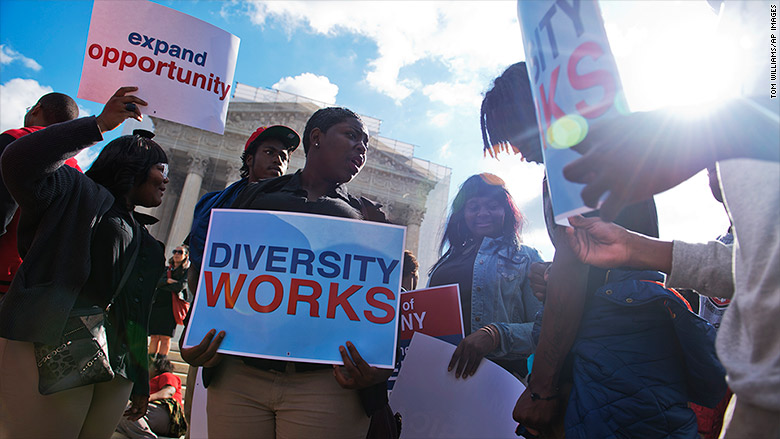
When it comes to college admissions, is economic class more important than race?
That's one question emerging as the Supreme Court decides whether the University of Texas should stop considering an applicant's race as a factor in admissions.
So far, eight states have banned the use of race-based affirmative action entirely, prompting universities to consider other measures, like socioeconomic status, to ensure campus diversity.
Some experts argue that considering an applicant's class will be more fair for poor students, who are underrepresented in many top public universities. Others argue that eliminating race in the admissions process has actually made it harder for those schools to retain middle class applicants of color and will disproportionately advantage poor white students.
"Class is the bigger impediment to opportunity," said Richard Kahlenberg, a senior fellow at the Century Foundation, a progressive think tank. "Universities provide a bump up in admissions chances for African American and Latino students, nothing for low income students."
Kahlenberg argues that considering a student's class -- like whether they grew up in poverty -- would account for both racial and economic disparities and foster more diversity.
The extreme wealth gap among racial groups would support Kahlenberg's point: White families have a median wealth of about $134,000, compared to Hispanics at $13,900 and blacks at $11,000.
But wealth and other measures of class for admissions don't always achieve the same ethnic and racial diversity.
Take the University of California, which banned race-based affirmative action in 1996.
Nina Robinson, the associate president at the University of California, said the university gives "very heavy preference to socioeconomic status," including how many advanced placement classes the applicant's high school offered, how many family members went to college, whether the applicant was eligible for free lunch at school, and family income and family size.
The university has achieved socioeconomic diversity, particularly among low-income whites and Asian students, Robinson said, but black student enrollment has remained low.
Another issue is the impact on black students who do attend. If the remaining black students on UC campuses are extremely poor or went to bad schools, "that reinforces stereotypes," Robinson said.
That could happen if talented, qualified, middle class black students who may be denied admission to the University of California for not being economically disadvantaged enough opt to go to schools in other states or to elite private schools like Duke and Yale, Robinson said. Those schools can still consider race based affirmative action and may even be able to offer students more competitive financial aid packages.
Finally, though black and Hispanic families on average have less wealth than whites, overall, there are many more poor white families.
While blacks and Hispanics are more likely to live in poverty (27% of blacks and 24% of Hispanics compared to 10% of whites) there are more poor whites (19 million) than there are poor blacks (10.3 million) and Hispanics (12.8 million).
That means poor whites "are going to get admitted in higher numbers," said Deborah Archer, the director of the Racial Justice Project and a professor at New York Law School.
What about fairness?
Is affirmative action unfair to whites, particularly poor ones?
Richard Lempert, a professor of law and sociology emeritus at the University of Michigan, said that "ignores the high amount of unfairness built into our society," including how blacks of all classes have been disproportionately disadvantaged by unfair and illegal housing practices like redlining, lower home values, generations of incarceration and segregated and underperforming schools.
Sheryll Cashin, a professor at Georgetown Law and the author of the book "Place Not Race" said that substituting socioeconomic status for race in affirmative action admissions fails to "accurately account for the serious structural disadvantage of segregation that most black and Latino students face."
However, Cashin also says that universities that only consider race and not socioeconomic status "achieve a skin color diversity that does not mitigate segregation, wealth disparities or other serious structural disadvantages that are causing opportunity hoarding in access to selective colleges."
In her book, Cashin suggests giving special consideration to students from segregated high schools and neighborhoods as well as to students who come from low family wealth or single parent homes.
Kedra Ishop, the associate vice president for enrollment at the University of Michigan, which banned affirmative action in 2006, pointed to two programs the university recently began, including one to encourage high achieving low-income students to apply to the university and a college-prep program that awards scholarships to admitted students.
And while Ishop does not have hard numbers to show that the school is losing its middle class black students, she does acknowledge, anecdotally at least, that the school has lost some of these students to private institutions offering race based scholarships and other financial incentives. "There reaches a point where we just can't compete," Ishop said.
